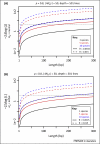Comparative population genomics: power and principles for the inference of functionality
- PMID: 24656563
- PMCID: PMC4073783
- DOI: 10.1016/j.tig.2014.02.002
Comparative population genomics: power and principles for the inference of functionality
Abstract
The availability of sequenced genomes from multiple related organisms allows the detection and localization of functional genomic elements based on the idea that such elements evolve more slowly than neutral sequences. Although such comparative genomics methods have proven useful in discovering functional elements and ascertaining levels of functional constraint in the genome as a whole, here we outline limitations intrinsic to this approach that cannot be overcome by sequencing more species. We argue that it is essential to supplement comparative genomics with ultra-deep sampling of populations from closely related species to enable substantially more powerful genomic scans for functional elements. The convergence of sequencing technology and population genetics theory has made such projects feasible and has exciting implications for functional genomics.
Copyright © 2014 Elsevier Ltd. All rights reserved.
Figures

Similar articles
-
A case for evolutionary genomics and the comprehensive examination of sequence biodiversity.Mol Biol Evol. 2000 Dec;17(12):1776-88. doi: 10.1093/oxfordjournals.molbev.a026278. Mol Biol Evol. 2000. PMID: 11110893 Review.
-
Genomic resources and their influence on the detection of the signal of positive selection in genome scans.Mol Ecol. 2016 Jan;25(1):170-84. doi: 10.1111/mec.13468. Epub 2015 Dec 17. Mol Ecol. 2016. PMID: 26562485 Review.
-
Population genomics: whole-genome analysis of polymorphism and divergence in Drosophila simulans.PLoS Biol. 2007 Nov 6;5(11):e310. doi: 10.1371/journal.pbio.0050310. PLoS Biol. 2007. PMID: 17988176 Free PMC article.
-
Faster than neutral evolution of constrained sequences: the complex interplay of mutational biases and weak selection.Genome Biol Evol. 2011;3:383-95. doi: 10.1093/gbe/evr032. Epub 2011 Apr 17. Genome Biol Evol. 2011. PMID: 21498884 Free PMC article.
-
Comparative genomics and the study of evolution by natural selection.Mol Ecol. 2008 Nov;17(21):4586-96. doi: 10.1111/j.1365-294X.2008.03954.x. Mol Ecol. 2008. PMID: 19140982 Review.
Cited by
-
Approximation to the distribution of fitness effects across functional categories in human segregating polymorphisms.PLoS Genet. 2014 Nov 6;10(11):e1004697. doi: 10.1371/journal.pgen.1004697. eCollection 2014 Nov. PLoS Genet. 2014. PMID: 25375159 Free PMC article.
-
Linkage disequilibrium between rare mutations.Genetics. 2022 Apr 4;220(4):iyac004. doi: 10.1093/genetics/iyac004. Genetics. 2022. PMID: 35100407 Free PMC article.
-
Comparative Population Genetics in the Human Gut Microbiome.Genome Biol Evol. 2022 Jan 4;14(1):evab116. doi: 10.1093/gbe/evab116. Genome Biol Evol. 2022. PMID: 34028530 Free PMC article.
-
Purifying selection against spurious splicing signals contributes to the base composition evolution of the polypyrimidine tract.J Evol Biol. 2023 Sep;36(9):1295-1312. doi: 10.1111/jeb.14205. Epub 2023 Aug 11. J Evol Biol. 2023. PMID: 37564008 Free PMC article.
-
Within-patient mutation frequencies reveal fitness costs of CpG dinucleotides and drastic amino acid changes in HIV.PLoS Genet. 2018 Jun 28;14(6):e1007420. doi: 10.1371/journal.pgen.1007420. eCollection 2018 Jun. PLoS Genet. 2018. PMID: 29953449 Free PMC article.
References
Publication types
MeSH terms
Grants and funding
LinkOut - more resources
Full Text Sources
Other Literature Sources

